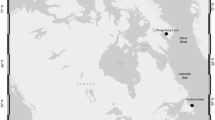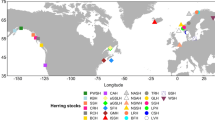Abstract
In the 1990s, a cold water event was associated with drastic changes in the biology of Newfoundland capelin (Mallotus villosus), the key forage fish in the north Atlantic. In contrast to studies conducted prior to the 1990s, we report a lower maximum potential fecundity (7,616–42,880) and a weak relationship between fecundity and body size based on fecundity of 218 female capelin (12.3–16.9 cm) collected within two coastal regions of Newfoundland in 2008 and 2009. Further, using forward stepwise multiple regression and hierarchical partitioning, we conclude that life history traits (mass, somatic mass and egg size) and condition indices (Fulton’s K, Hepatosomatic Index and Gonadosomatic Index) are not appropriate proxies for fecundity of capelin in our study area. Hierarchical partitioning revealed that egg size and condition indices suppress the variance in fecundity explained by other factors. Based on the insight it provides into the influence of traits on fecundity, we suggest that hierarchical partitioning is a powerful analysis technique that could be used in further investigations.



Similar content being viewed by others
References
Abramoff MD, Magelhaes PJ, Ram SI (2004) Image processing with ImageJ. Biophot Int 11:36–42
Carscadden J, Nakashima B. (1997) Abundance and changes in distribution, biology, and behavior of capelin in response to cooler waters of the 1990s. In: Forage fishes in marine ecosystems. Lowell Wakefield Fisheries Symposium Series, pp 457–468
Carscadden J, Vilhjálmsson H (2002) Capelin—what are they good for? ICES J Mar Sci 59:863–869
Carscadden J, Frank K, Leggett W (2000) Evaluation of an environment-recruitment model for capelin (Mallotus villosus). ICES J Mar Sci 57:412–418
Chevan A, Sutherland M (1991) Hierarchical partitioning. Am Stat 45:90–96
Christiansen J, Præbel K, Siikavuopio S, Carscadden J (2008) Facultative semelparity in capelin Mallotus villosus (Osmeridae)—an experimental test of a life history phenomenon in a sub-arctic fish. J Exp Mar Biol Ecol 360:47–55
Cushing D (1995) Population, production and regulation in the sea. Cambridge University Press, New York
Daniel ES, Parrish CC, Somerton DC, Brown JA (1993) Lipids in eggs from first-time and repeat spawning Atlantic halibut, Hippoglossus hippoglossus (L.). Aquacult Res 24:187–191
Davenport J, Stene A (1986) Freezing resistance, temperature and salinity tolerance in eggs, larvae and adults of capelin, Mallotus villosus, from Balsfjord. J Mar Biol Assoc UK 66:145–157
Flynn S, Nakashima B, Burton M (2001) Direct assessment of post-spawning survival of female capelin, Mallotus villosus. J Mar Biol Assoc UK 81:307–312
Frank K, Carscadden J (1989) Factors affecting recruitment variability of capelin (Mallotus villosus) in the northwest Atlantic. J Cons Int Explor Mer 45:146–164
Frank K, Leggett W (1982a) Environmental regulation of growth rate, efficiency, and swimming performance in larval capelin (Mallotus villosus), and its application to the match/mismatch hypothesis. Can J Fish Aquat Sci 39:691–699
Frank K, Leggett W (1982b) Coastal water mass replacement: its effect on zooplankton dynamics and the predator–prey complex associated with larval capelin (Mallotus villosus). Can J Fish Aquat Sci 39:991–1003
Friis-Rödel E, Kanneworff P (2002) A review of capelin (Mallotus villosus) in Greenland waters. ICES J Mar Sci 59:890–896
Galkin AS, Kovalev SM (1975) Fecundity of the capelin Mallotus villosus villosus of the Barents Sea. J Ichthyol 15:579–583
Gjøsæter J, Monstad T (1973) Fecundity and egg size of spring spawning Barents Sea capelin. Fiskeridir skr Ser havunders 16:98–104
Graham MH (2003) Confronting multicollinearity in ecological multiple regression. Ecology 84:2809–2815
Green BS (2008) Maternal effects in fish populations. Adv Mar Biol 54:1–105
Grégoire F, Morneau R, Caron G, Beaudoin M, Lévesque C, Rose C, Felix A, Hudon J (2004) Fertility of the capelan (Mallotus villosus) in the estuary and the gulf of Saint-laurent in 2003. Can Tech Rep Fish Aquat Sci 2560:1
Hedeholm R, Grønkjær P, Rysgaard S (2011) Energy content and fecundity of capelin (Mallotus villosus) along a 1,500-km latitudinal gradient. Mar Biol 158:1319–1330
Hill T, Lewecki P (2006) Statistics methods and applications. Statsoft, Tulsa
Hunter JR, Macewicz BJ, Lo NCH, Kimbrell CA (1992) Fecundity, spawning, and maturity of female Dover Sole, Microstomus pacificus, with an evaluation of assumptions and precision. Fish Bull 90:101–128
Huse G, Gjøsæter H (1997) Fecundity of the Barents Sea capelin (Mallotus villosus). Mar Biol 130:309–313
Jangaard PM (1974) The capelin (Mallotus villosus); biology, distribution, exploitation, utilization, and composition. Bull Fish Res Board Can 186:1–70
Jóhannsdóttir S, Vilhjálmsson H (1999) Fecundity of Icelandic capelin Mallotus villosus (Müller). Rit Fiskideildar 16:263–270
Jokikokko E, Jutila E (2005) Effect of fishing regulation on the occurrence of repeat spawners and age distribution of Atlantic salmon in a northern Baltic river. Fish Manage Ecol 12:341–347
Kamler E (2005) Parent–egg–progeny relationships in teleost fishes: an energetics perspective. Rev Fish Biol Fish 15:399–421
Kjesbu OS, Holm JC (1994) Oocyte recruitment in first-time spawning Atlantic cod (Gadus morhua) in relation to feeding regime. Can J Fish Aquat Sci 51:1893–1898
Kjesbu OS, Klungsøyr J, Kryvi H, Witthames PR, Greer Walker M (1991) Fecundity, atresia, and egg size of captive Atlantic cod (Gadus morhua) in relation to proximate body-composition. Can J Fish Aquat Sci 48:2333–2343
Koops MA, Hutchings JA, McIntyre TM (2004) Testing hypotheses about fecundity, body size and maternal condition in fishes. Fish Fish 5:120–130
Lambert Y (2008) Why should we closely monitor fecundity in marine fish populations? J Northwest Atl Fish Sci 41:93–106
Lambert Y, Yaragina NA, Kraus G, Marteinsdottir G, Wright PJ (2003) Using environmental and biological indices as proxies for egg and larval production of marine fish. J Northwest Atl Fish Sci 33:115–159
Leggett W, Frank K, Carscadden J (1984) Meteorological and hydrographic regulation of year-class strength in capelin (Mallotus villosus). Can J Fish Aquat Sci 41:1193–1201
Mac Nally R (1996) Hierarchical partitioning as an interpretative tool in multivariate inference. Aust J Ecol 21:224–228
McIntyre TM, Hutchings JA (2003) Small-scale temporal and spatial variation in Atlantic cod (Gadus morhua) life history. Can J Fish Aquat Sci 60:1111–1121
Morgan MJ, Shelton PA, Brattey J (2007) Age composition of the spawning stock does not always influence recruitment. J Northwest Atl Fish Sci 38:1–12
Motoda S (1959) Devices of simple plankton apparatus. Mem Fac Fish Hokkaido Univ 7(1/2):73–94
Murua H, Saborido-Rey F (2003) Female reproductive strategies of marine fish species of the north Atlantic. J Northwest Atl Fish Sci 33:23–31
Nakashima B (1987) Regional and temporal variations in fecundity of capelin in Newfoundland waters. Trans Am Fish Soc 116:864–873
Nakashima B (1996) The relationship between oceanographic conditions in the 1990s and changes in spawning behaviour, growth and early life history of capelin (Mallotus villosus). Scient Coun Stud NW Atlant Fish Orgn 24:55–68
Nakashima B, Wheeler J (2002) Capelin (Mallotus villosus) spawning behaviour in Newfoundland waters—the interaction between beach and demersal spawning. ICES J Mar Sci 59:909–916
Nissling A, Dahlman G (2010) Fecundity of flounder, Pleuronectes flesus, in the Baltic Sea—reproductive strategies in two sympatric populations. J Sea Res 64:190–198
Penton P, Davoren GK (2008) Patterns of larval emergence of capelin (Mallotus villosus) and environmental cues at demersal spawning sites on the northeastern coast of Newfoundland. Can J Fish Aquat Sci 65:1135–1143
Penton P, Davoren GK, Andrews D, Montevecchi WA (2012) A comparison of egg developmental and survival rates in capelin (Mallotus villosus) on beach and demersal spawning sites in Newfoundland. Can J Zool 90:248–256
Quinn GP, Keough MJ (2002) Experimental design and data analysis for biologists. Cambridge University Press, New York
Snyder DE (1983) Fish eggs and larvae. In: Nielsen LA, Johnson DL (eds) Fisheries techniques. Am Fish Soc, Bethesda, pp 165–197
Templeman W (1948) The life history of capelin (Mallotus villosus O.F. Müller) in Newfoundland waters. Bull Nfld Gov Lab 17:1–151
Tereshchenko E (2002) The dynamics of population fecundity in Barents Sea capelin. ICES J Mar Sci 59:976–982
Thorstad EB, Whoriskey F, Rikardsen AH, Aarestrup K (2010) Aquatic nomads: the life and migrations of Atlantic salmon. In: Aas Ø, Einum S, Klemetsen A, Skurdal J (eds) Atlantic salmon ecology. Wiley-Blackwell Publishing, Iowa, pp 1–32
Vilhjalmsson H (1994) The Icelandic capelin stock: Capelin, Mallotus villosus (Müller) in the Iceland, Greenland-Jan mayen area. Rit Fiskideildar 13:1–281
Winters G (1971) Fecundity of the left and right ovaries of grand bank capelin (Mallotus villosus). J Fish Res Bd Can 28:1029–1033
Wootton RJ (1998) Ecology of teleost fishes. Kluwer Academic Publishers, Norwell
Wright PJ, Trippel EA (2009) Fishery-induced demographic changes in the timing of spawning: consequences for reproductive success. Fish Fish 10:283–304
Acknowledgments
We thank M. Clarke and L. Boudreau for their assistance and dedication in the field and E. Maxner for assistance in the laboratory. We thank B. Nakashima, J. Wheeler, B. Slaney and F. Dawson from Fisheries and Oceans Canada (St. John’s, NL) for their assistance with sample collection in Trinity Bay, as well as Larry Easton and the crew of the Lady Easton II for sample collection in Notre Dame Bay. Principal funding was provided by Natural Sciences and Engineering Research Council of Canada (NSERC) Discovery and Ship Time grants to GKD.
Author information
Authors and Affiliations
Corresponding author
Additional information
Communicated by C. Harrod.
Rights and permissions
About this article
Cite this article
Penton, P.M., Davoren, G.K. Capelin (Mallotus villosus) fecundity in post-1990s coastal Newfoundland. Mar Biol 160, 1625–1632 (2013). https://doi.org/10.1007/s00227-013-2215-7
Received:
Accepted:
Published:
Issue Date:
DOI: https://doi.org/10.1007/s00227-013-2215-7




